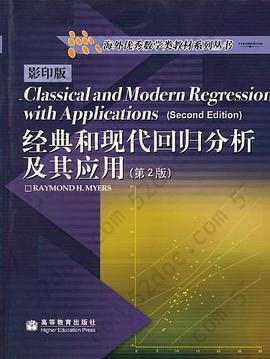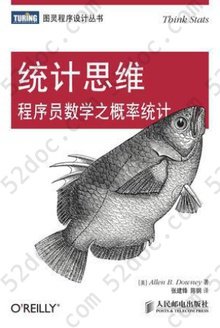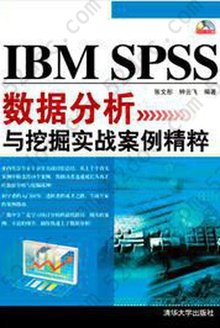注重体验与质量的电子书资源下载网站
分类于: 云计算&大数据 编程语言
简介

经典和现代回归分析及其应用: 海外优秀数学类教材系列丛书 豆 0.0分
资源最后更新于 2020-09-05 22:07:01
作者:[美] 麦尔斯
出版社:高等教育
出版日期:2008-01
ISBN:9787040163230
文件格式: pdf
标签: 回归分析 数学 统计 英文原版 社会学 专业相关 statistics methodology
简介· · · · · ·
本书从Thomson Learning出版公司引进,本书内容包括:回归分析,简单线性回归模型,多元线性回归模型,最佳模型的标准选择,残差分析,影响诊断,非标准条件、假设和转换,检测及多元共线性,非线性回归,附录A:矩阵代数中的一些概念,附录B:一些处理方法,附录C:统计表。 本书适用于高等院校统计学专业和理工科各专业本科生和研究生作为教材使用。
目录
CHAPTER 1
INTRODUCTION: REGRESSION ANALYSIS
Regression models
Formal uses of regression analysis
The data base
References
CHAPTER 2
THE SIMPLE LINEAR REGRESSION MODEL
The model description
Assumptions and interpretation of model parameters
Least squares formulation
Maximum likelihood estimation
Partioning total variability
Tests of hypothesis on slope and intercept
Simple regression through the origin (Fixed intercept)
Quality of fitted model
Confidence intervals on mean response and prediction intervals
Simultaneous inference in simple linear regression
A complete annotated computer printout
A look at residuals
Both x and y random
Exercises
References
CHAPTER 3
THE MULTIPLE LINEAR REGRESSION MODEL
Model description and assumptions
The general linear mode] and the least squares procedure
Properties of least squares estimators under ideal conditions
Hypothesis testing in multiple linear regression
Confidence intervals and prediction intervals in multiple regressions
Data with repeated observations
Simultaneous inference in multiple regression
Multicollinearity in multiple regression data
Quality fit, quality prediction, and the HAT matrix
Categorical or indicator variables (Regression models and ANOVA models)
Exercises
References
CHAPTER 4
CRITERIA FOR CHOICE OF BEST MODEL
Standard criteria for comparing models
Cross validation for model selection and determination of model performance
Conceptual predictive criteria (The Cp statistic)
Sequential variable selection procedures
Further comments and all possible regressions
Exercises
References
CHAPTER 5
ANALYSIS OF RESIDUALS 209
Information retrieved from residuals
Plotting of residuals
Studentized residuals
Relation to standardized PRESS residuals
Detection of outliers
Diagnostic plots
Normal residual plots
Further comments on analysis of residuals
Exercises
References
CHAPTER 6
INFLUENCE DIAGNOSTICS
Sources of influence
Diagnostics: Residuals and the HAT matrix
Diagnostics that determine extent of influence
Influence on performance
What do we do with high influence points?
Exercises
References
CHAPTER 7
NONSTANDARD CONDITIONS, VIOLATIONS OF ASSUMPTIONS,AND TRANSFORMATIONS
Heterogeneous variance: Weighted least squares
Problem with correlated errors (Autocorrelation)
Transformations to improve fit and prediction
Regression with a binary response
Further developments in models with a discrete response (Poisson regression)
Generalized linear models
Failure of normality assumption: Presence of outliers
Measurement errors in the regressor variables
Exercises
References
CHAPTER 8
DETECTING AND COMBATING MULTICOLLINEARITY
Multicollinearity diagnostics
Variance proportions
Further topics concerning multicollinearity
Alternatives to least squares in cases of multicollinearity
Exercises
References
CHAPTER 9
NONLINEAR REGRESSION
Nonlinear least squares
Properties of the least squares estimators
The Gauss-Newton procedure for finding estimates
Other modifications of the Gauss-Newton procedure
Some special classes of nonlinear models
Further considerations in nonlinear regression
Why not transform data to linearize?
Exercises
References
APPENDIX A
SOME SPECIAL CONCEPTS IN MATRIX ALGEBRA
Solutions to simultaneous linear equations
Quadratic form
Eigenvalues and eigenvectors
The inverses of a partitioned matrix
Sherman-Morrison-Woodbury theorem
References
APPENDIX B
SOME SPECIAL MANIPULATIONS
Unbiasedness of the residual mean square
Expected value of residual sum of squares and mean square
for an underspecified model
The maximum likelihood estimator
Development of the PRESS statistic
Computation of s _ i
Dominance of a residual by the corresponding model error .Computation of influence diagnostics
Maximum likelihood estimator in the nonlinear model
Taylor series
Development of the Ck-statistic
References
APPENDIX C
STATISTICAL TABLES
INDEX
INTRODUCTION: REGRESSION ANALYSIS
Regression models
Formal uses of regression analysis
The data base
References
CHAPTER 2
THE SIMPLE LINEAR REGRESSION MODEL
The model description
Assumptions and interpretation of model parameters
Least squares formulation
Maximum likelihood estimation
Partioning total variability
Tests of hypothesis on slope and intercept
Simple regression through the origin (Fixed intercept)
Quality of fitted model
Confidence intervals on mean response and prediction intervals
Simultaneous inference in simple linear regression
A complete annotated computer printout
A look at residuals
Both x and y random
Exercises
References
CHAPTER 3
THE MULTIPLE LINEAR REGRESSION MODEL
Model description and assumptions
The general linear mode] and the least squares procedure
Properties of least squares estimators under ideal conditions
Hypothesis testing in multiple linear regression
Confidence intervals and prediction intervals in multiple regressions
Data with repeated observations
Simultaneous inference in multiple regression
Multicollinearity in multiple regression data
Quality fit, quality prediction, and the HAT matrix
Categorical or indicator variables (Regression models and ANOVA models)
Exercises
References
CHAPTER 4
CRITERIA FOR CHOICE OF BEST MODEL
Standard criteria for comparing models
Cross validation for model selection and determination of model performance
Conceptual predictive criteria (The Cp statistic)
Sequential variable selection procedures
Further comments and all possible regressions
Exercises
References
CHAPTER 5
ANALYSIS OF RESIDUALS 209
Information retrieved from residuals
Plotting of residuals
Studentized residuals
Relation to standardized PRESS residuals
Detection of outliers
Diagnostic plots
Normal residual plots
Further comments on analysis of residuals
Exercises
References
CHAPTER 6
INFLUENCE DIAGNOSTICS
Sources of influence
Diagnostics: Residuals and the HAT matrix
Diagnostics that determine extent of influence
Influence on performance
What do we do with high influence points?
Exercises
References
CHAPTER 7
NONSTANDARD CONDITIONS, VIOLATIONS OF ASSUMPTIONS,AND TRANSFORMATIONS
Heterogeneous variance: Weighted least squares
Problem with correlated errors (Autocorrelation)
Transformations to improve fit and prediction
Regression with a binary response
Further developments in models with a discrete response (Poisson regression)
Generalized linear models
Failure of normality assumption: Presence of outliers
Measurement errors in the regressor variables
Exercises
References
CHAPTER 8
DETECTING AND COMBATING MULTICOLLINEARITY
Multicollinearity diagnostics
Variance proportions
Further topics concerning multicollinearity
Alternatives to least squares in cases of multicollinearity
Exercises
References
CHAPTER 9
NONLINEAR REGRESSION
Nonlinear least squares
Properties of the least squares estimators
The Gauss-Newton procedure for finding estimates
Other modifications of the Gauss-Newton procedure
Some special classes of nonlinear models
Further considerations in nonlinear regression
Why not transform data to linearize?
Exercises
References
APPENDIX A
SOME SPECIAL CONCEPTS IN MATRIX ALGEBRA
Solutions to simultaneous linear equations
Quadratic form
Eigenvalues and eigenvectors
The inverses of a partitioned matrix
Sherman-Morrison-Woodbury theorem
References
APPENDIX B
SOME SPECIAL MANIPULATIONS
Unbiasedness of the residual mean square
Expected value of residual sum of squares and mean square
for an underspecified model
The maximum likelihood estimator
Development of the PRESS statistic
Computation of s _ i
Dominance of a residual by the corresponding model error .Computation of influence diagnostics
Maximum likelihood estimator in the nonlinear model
Taylor series
Development of the Ck-statistic
References
APPENDIX C
STATISTICAL TABLES
INDEX








